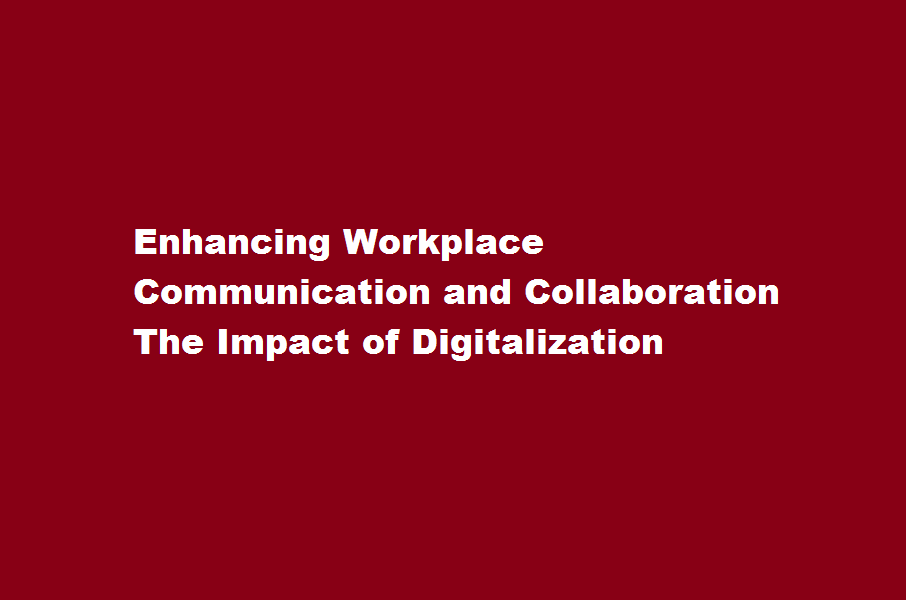Enhancing Workplace Communication and Collaboration The Impact of Digitalization
4 min read
Introduction
Digitalization has brought about transformative changes in the way we work, particularly in communication and collaboration within the workplace. Through the integration of digital technologies, organizations have witnessed significant improvements in team collaboration, knowledge sharing, and overall productivity. This article explores the profound impact of digitalization on workplace communication and collaboration, highlighting the benefits and innovative tools that have revolutionized the way teams work together.
Real-Time Communication and Remote Collaboration
Digitalization has facilitated real-time communication among team members, regardless of their physical locations. Instant messaging, video conferencing, and collaboration tools have bridged the gap between remote teams, enabling seamless communication and collaboration. Team members can connect and exchange information instantaneously, fostering faster decision-making, efficient problem-solving, and improved project management.
Enhanced Knowledge Sharing and Information Access
Digitalization has made knowledge sharing and information access more convenient and efficient. Through digital platforms such as intranets, wikis, and cloud-based storage systems, employees can easily share documents, collaborate on projects, and access critical information. This enables teams to work together on shared documents, provide feedback in real-time, and access relevant data from anywhere, fostering a culture of knowledge sharing and continuous learning.
Collaboration Tools and Project Management Platforms
Digitalization has given rise to a wide range of collaboration tools and project management platforms designed to streamline teamwork and enhance productivity. These tools facilitate task assignment, progress tracking, document sharing, and centralized communication, keeping everyone on the same page and ensuring transparency across projects. With features like shared calendars, task reminders, and file version control, teams can work collaboratively and efficiently, minimizing delays and improving project outcomes.
Virtual Meetings and Webinars
Digitalization has transformed the way meetings and webinars are conducted. Virtual meeting platforms enable participants to connect from different locations, reducing travel costs and time constraints. Webinars allow organizations to host interactive presentations, workshops, and training sessions remotely, reaching a larger audience and promoting knowledge dissemination. These digital tools foster engagement, participation, and collaboration, making meetings and training sessions more accessible and impactful.
Social Intranets and Enterprise Social Networks
Digitalization has given rise to social intranets and enterprise social networks, creating digital spaces for employees to connect, collaborate, and share ideas. These platforms mimic popular social media interfaces, allowing employees to post updates, comment on discussions, and collaborate in real-time. Social intranets foster a sense of community, encourage cross-departmental collaboration, and facilitate the exchange of ideas and best practices.
Mobile and Remote Work Capabilities
Digitalization has enabled mobile and remote work capabilities, empowering employees to work anytime and from anywhere. Mobile devices and cloud-based applications allow teams to stay connected, access documents, and collaborate on the go. Remote work arrangements provide flexibility, improve work-life balance, and foster collaboration among geographically dispersed teams. Digitalization has made the concept of the traditional office space less rigid, enabling organizations to embrace remote work models and leverage global talent.
Frequently Asked Questions
How has digitalization improved team collaboration and productivity?
Digitalization has improved team collaboration and productivity by enabling real-time communication, providing efficient knowledge sharing platforms, streamlining project management, and fostering remote collaboration. Teams can collaborate seamlessly, share information, and work together on projects from anywhere, resulting in increased productivity and better outcomes.
What are some popular digital collaboration tools used in the workplace?
Some popular digital collaboration tools used in the workplace include project management platforms like Asana and Trello, communication tools like Slack and Microsoft Teams, document sharing platforms like Google Drive and SharePoint, and virtual meeting platforms like Zoom and Microsoft Teams.
How does digitalization promote cross-departmental collaboration?
Digitalization promotes cross-departmental collaboration by providing platforms like social intranets and enterprise social networks, where employees from different departments can connect, share ideas, and collaborate on projects. These platforms break down silos, encourage knowledge sharing, and facilitate a more collaborative work environment.
Can digitalization improve communication and collaboration in global organizations?
Yes, digitalization significantly improves communication and collaboration in global organizations. Through real-time communication tools, cloud-based platforms, and remote work capabilities, teams across different time zones and locations can collaborate effectively, share information, and work together seamlessly, fostering a global collaborative culture.
Conclusion
Digitalization has revolutionized workplace communication and collaboration, breaking down barriers and enabling teams to work together seamlessly, regardless of their physical locations. Real-time communication tools, collaboration platforms, and mobile work capabilities have transformed the way teams connect, share information, and collaborate on projects. By embracing digitalization, organizations can create a collaborative work environment, improve productivity, and foster innovation, ultimately driving their success in the digital age.
Read Also : Navigating The Impact of Digitalization on Data Privacy and Cybersecurity





